Pitcher plants of Sabah belong to the genus Nepenthes. Some call them “Monkey Cup.” Pitcher plant is one of the coolest plants on earth because it can “catch” bugs without chasing around. Pitcher Plants normally grow in places where the soil is very poor in nutrients, especially nitrogen.
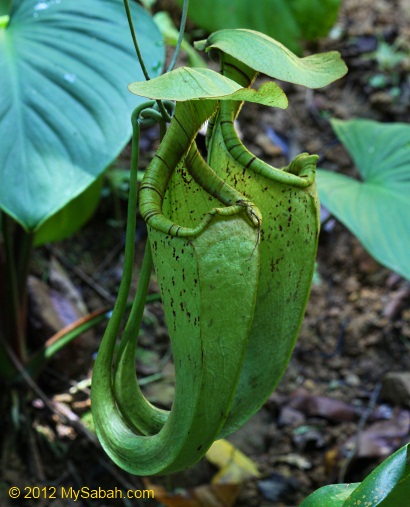
To survive, they become carnivorous plants that are equipped with pitfall trap, consists of a deep cupped cavity filled with liquid. The lethal bait is the nectar of the pitcher that makes it smells like a jug of irresistible honey. Insects which forage for sweet food will fall accidentally into the deep cavity, drown in the digestive liquid and consumed by pitcher plant.
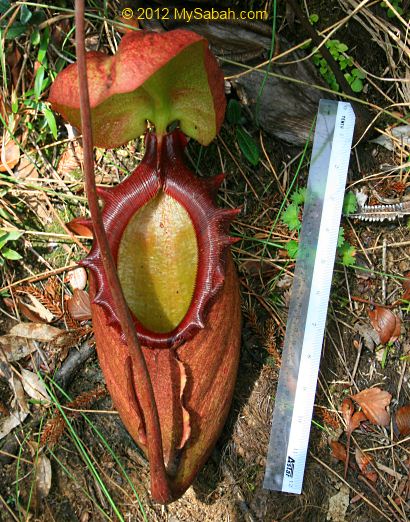
To learn more about this fascinating plant, I interviewed a pitcher plant named “Pit” who is fond of eating bugs.
Pit: Hello! I am Pit, a Nepenthesis Rajah (species name) from Sabah. Rajah is the world’s biggest pitcher plant that can hold 1.5 to 2 Litres of water. I am only found in Mesilau, Kinabalu Park and Mt. Tambuyukon, that means I am endemic to Sabah.
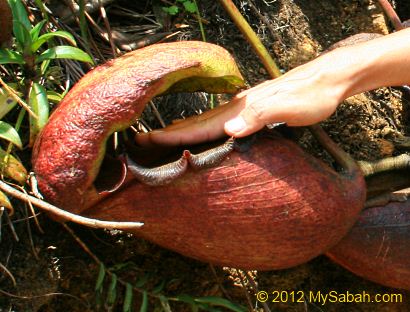
MySabah: You make Sabahans proud. But wait! Are you man-eater?
Pit: Nepenthesis Rajah can grow up to 35cm. There were two documented cases of mouse corpses found in pitchers and our cup can trap small animals such as frog and lizards, but no, pitcher plant is not big enough to eat human though we wish. We cannot move so we cannot bite, unlike the common myth saying that we can open and close our lids to chew your fingers.
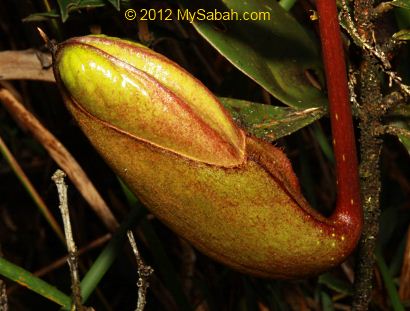
Above: pitcher plant about to open. The locals say the serum inside virgin nepenthes is used as hair tonic
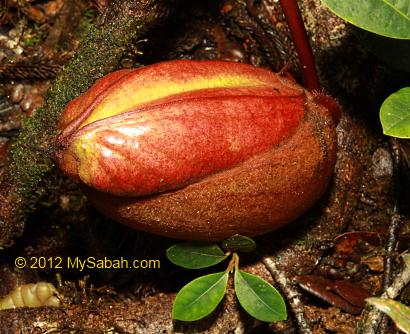
MySabah: 35cm!!? WOW, you are such a huge fruit!
Pit: Wrong. The pitcher is not a fruit. It does not make sense for flower to kill pollinators that visit it, right? As a matter of fact, the pitcher is the modified tip of a leaf that has evolved to trap insects. Pitcher plants do have small flowers that attract different kinds of insects for pollination.
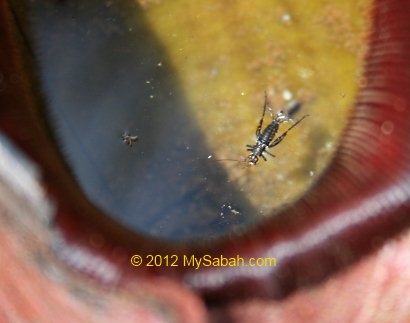
Above: insect trapped inside pitcher plant
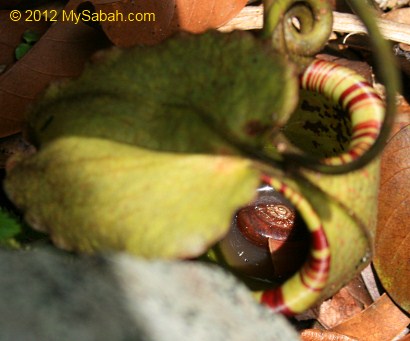
Above: snail trapped inside pitcher plant
MySabah: Is the murky fluid in pitcher poisonous?
Pit: The water in pitcher contains highly acidic enzymes (sometimes up to pH 1.90!) to digest the prey and some wetting agents that make their escape harder. However, most captured insects died of drowning when they fail to climb out from our smooth inner wall, instead of being killed by the acid. The liquid is acidic, smelly and full of bacteria, so drinking it will lead to very uncomfortable consequences. You have been warned!
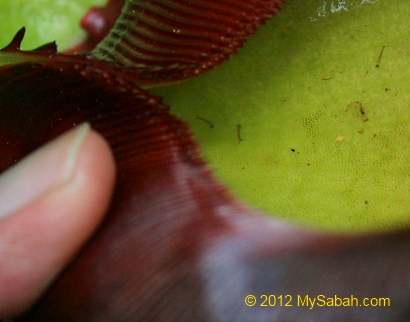
Above: larvae of mosquito inside pitcher plant
MySabah: Weird… How come I saw mosquito larvae swim happily in your “gastric” then?
Pit: Oh yes. Larvae of certain insects such as mosquito and flies, live in the pitchers during juvenile stage, have adapted to the acidic environment. Actually they also help to break up the carcasses of the death bugs so my enzymes can decompose the prey easier. By sharing food, they also keep my cup clean by removing excessive organic leftover. The insects will leave me after they grow up and fly away, never return again except for laying eggs.
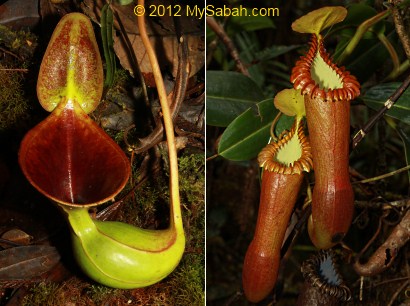
Photos: endemic pitcher plant of Sabah
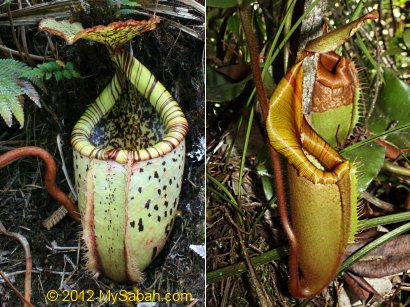
MySabah: How many species of pitcher plants are found?
Pit: There are about 160 species of Nepenthes in the world. Most of them are concentrated in South-East Asia. 39 species are found in Borneo and 22 species are found in Sabah. Six out of the 22 species are endemic to Sabah, with four endemic to Mount Kinabalu (N. burbidgeae, N. edwardsiana, N. rajah, N. villosa), one endemic to Mount Trus Madi (N. macrophylla) and one obligate ultramafic species (N. macrovulgaris).
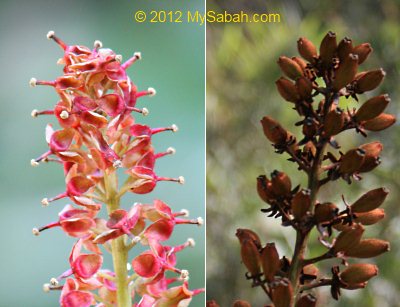
Above: flower of nepenthes (left is male, right is female)
Most pitcher plant species have very restricted geography distribution. Sometimes two different species crossbreed with each other naturally to produce a hybrid, such as Nepenthes xkinbaluensis (fusion of Nepenthes rajah and Nepenthes villosa).
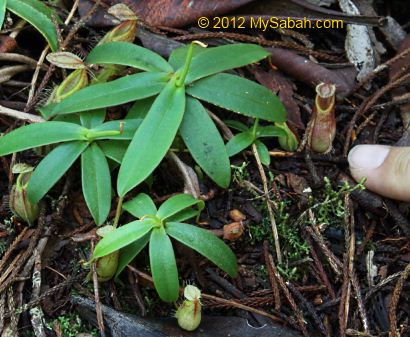
New species is found at a rate of 1 to 2 every year. In October of 2006, Dr Charles Clarke discovered a new species on Gunung Alab (highest peak of Crocker Range Park) in Sabah, and named it as Nepenthes chaniana after Sabahan Datuk CL Chan. This is the first nepenthes species named after Malaysian!
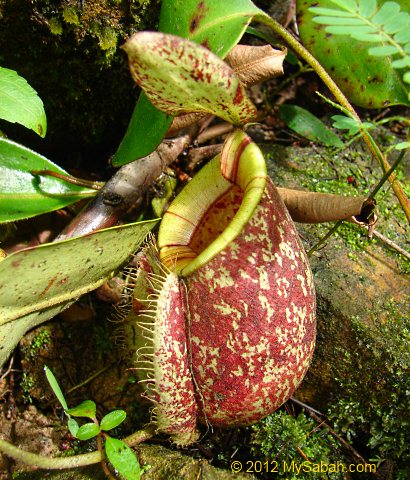
MySabah: You are so cute. Can I plant you in my garden?
Pit: All pitcher plant species are protected in Sabah. For people who possess or trade pitcher plants without a license, they can be fined RM5,000 or being jailed for 2 years, or both. In severe case, the penalty fee can reach RM10,000 (USD3,000++). You can buy a diamond for that price. Besides, pitcher plant is hard to cultivate in-house, most of them die under human care.
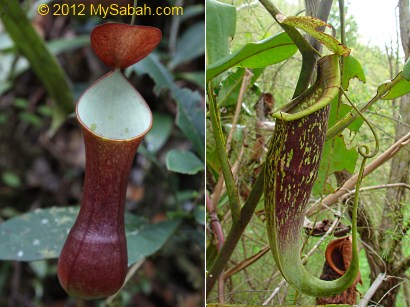
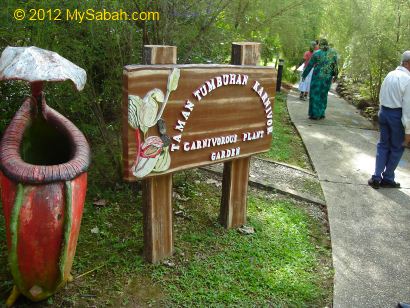
Above: Nepenthes Garden of Tenom Agriculture Park
MySabah: Many tourists would love to meet pitcher plants and get autograph of them. Where are the best places to find you all?
Pit: If you would like to see many species in a garden, you should check out Botanical Garden of Lokkawi Wildlife Park or Carnivorous Plant Garden of Sabah Agriculture Park in Tenom. They have collection of over 10 beautiful local and foreigner species. Even the roadsides to Beaufort, Papar-Kimanis, and Keningau have a few common Nepenthes species wait to be seen. If this is not close enough, you could look for them in nature jogging trail of Tun Fuad Stephens Park.
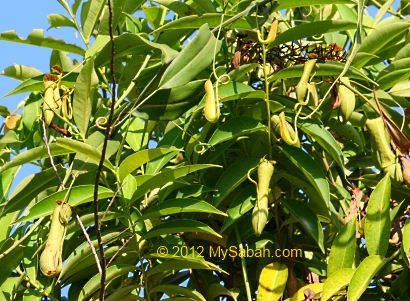
Above: wild pitcher plant at Tun Fuad Stephens Park
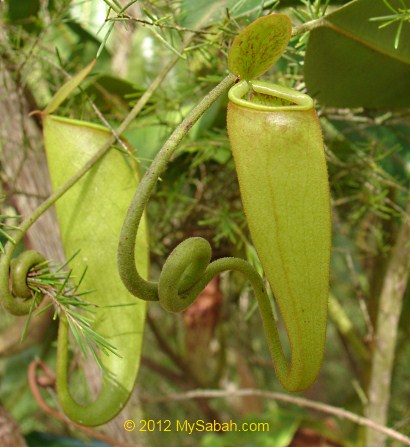
To see pitcher plants in the wild, Mesilau, Kinabalu Park, Maliau Basin, Mt. Trus Madi and Mt. Tambuyukon are the best spots to look for rare & endemic species. But you need to have very observant eyes because the colors of pitcher plants blend nicely in the wood. January to May is a good time as we grow well in wetter season.
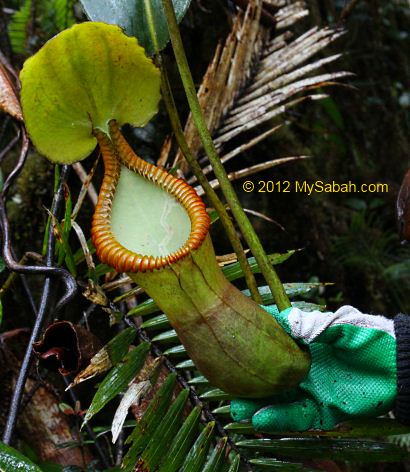
Above: rare Nepenthes macrophylla in Mt. Trus Madi
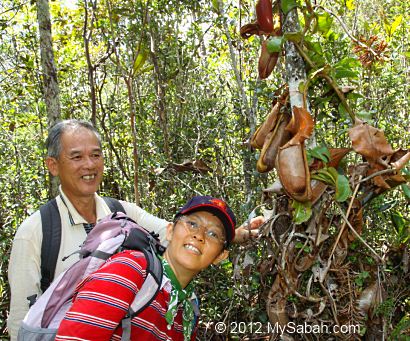
Above: pitcher plant in Maliau Basin
Pitcher plants are sensitive, so please do not touch it. If you have to, hold its body gently and do not flip its lid, which is the most fragile part, to see what is inside. While you enjoy watching them, please do not feed them with stuff such as cockroach, as pitcher cannot cope with a mouthful of bugs. Camera flash is believed to be harmful to us, so please use it sparingly. By being considerable, the next tourist can see our beauty intact.
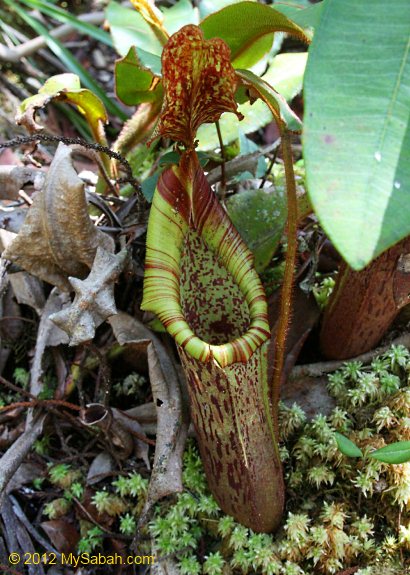
MySabah: Thank you so much, Pit!
Pit: You are welcome. For further info about us, you could read the book “A Guide to the Pitcher Plants of Sabah” published by Natural History Publications. All the best!
Photos taken in Sabah, Malaysia Borneo



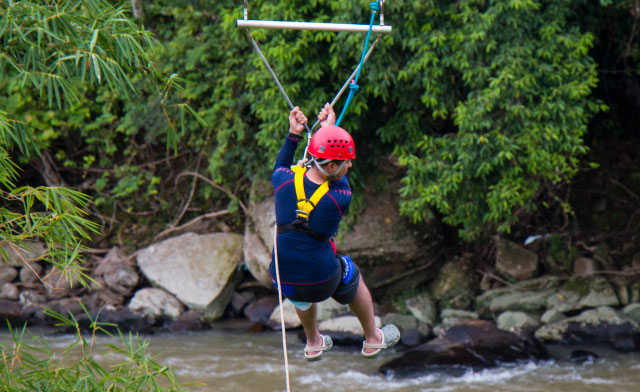
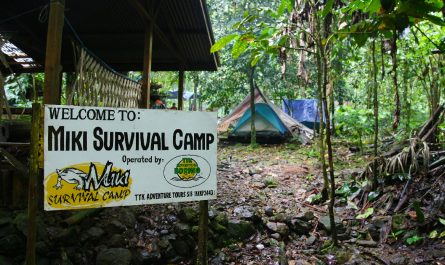
Top show Buddy, I will go thru it again, Ya!
Thanks.
haha, no prob David 🙂